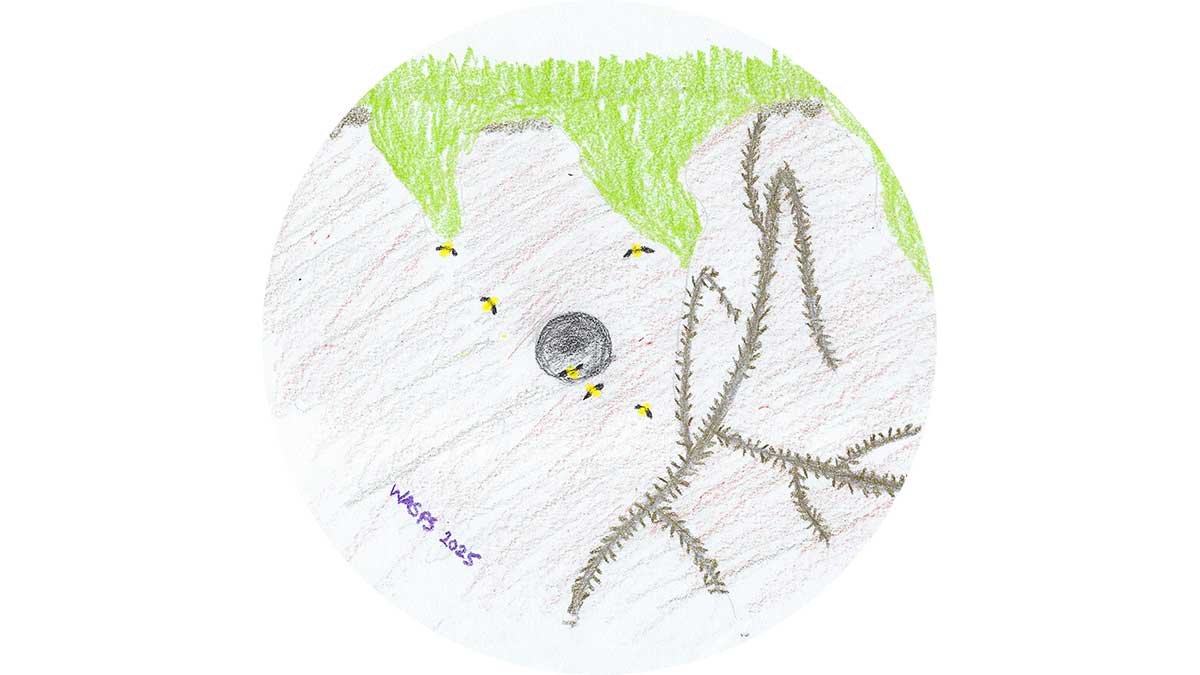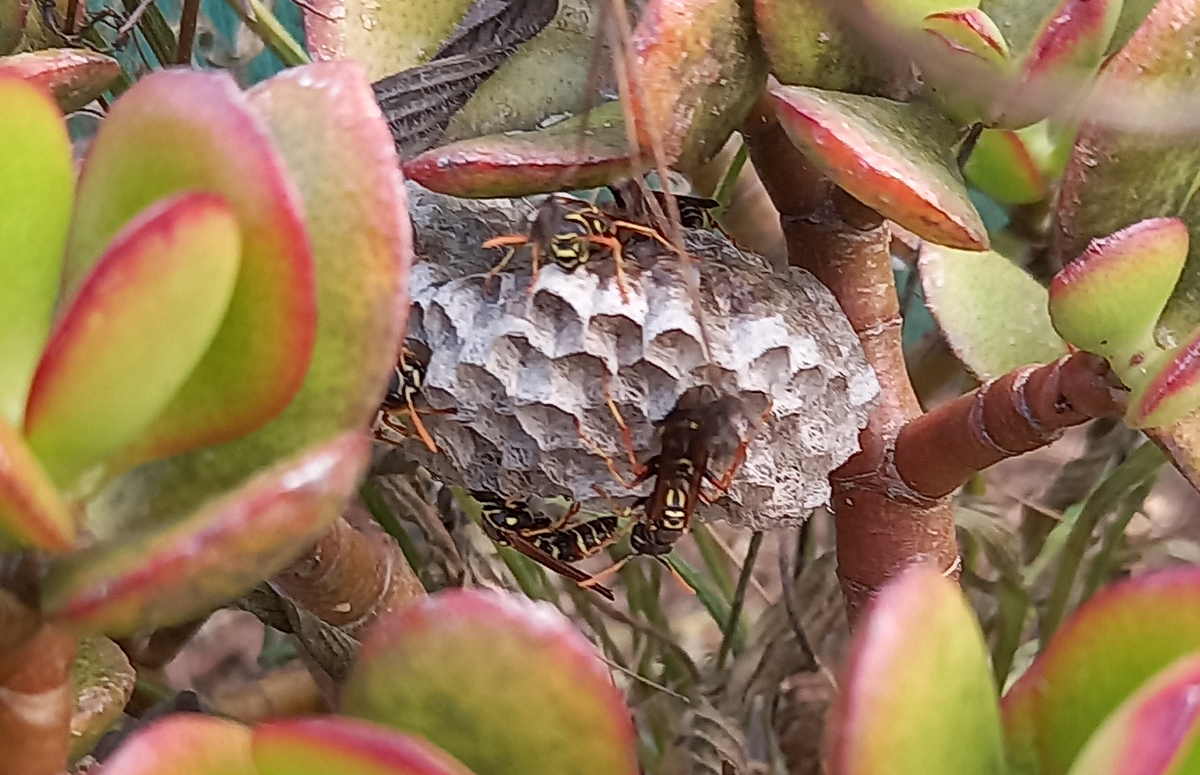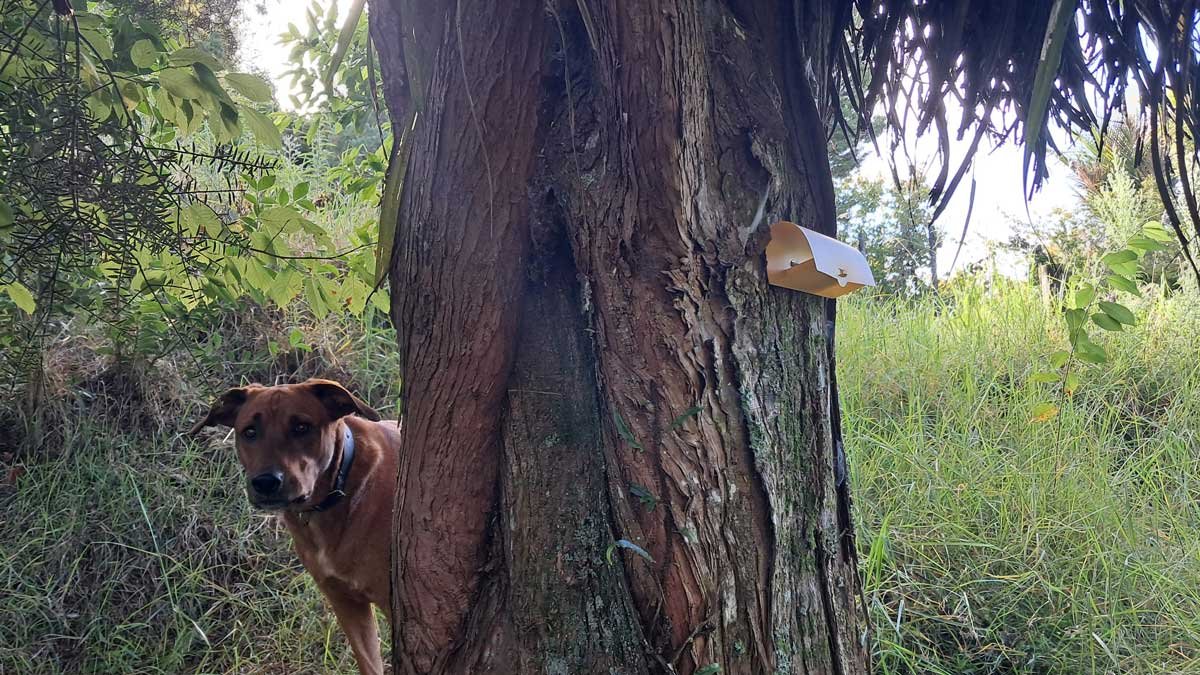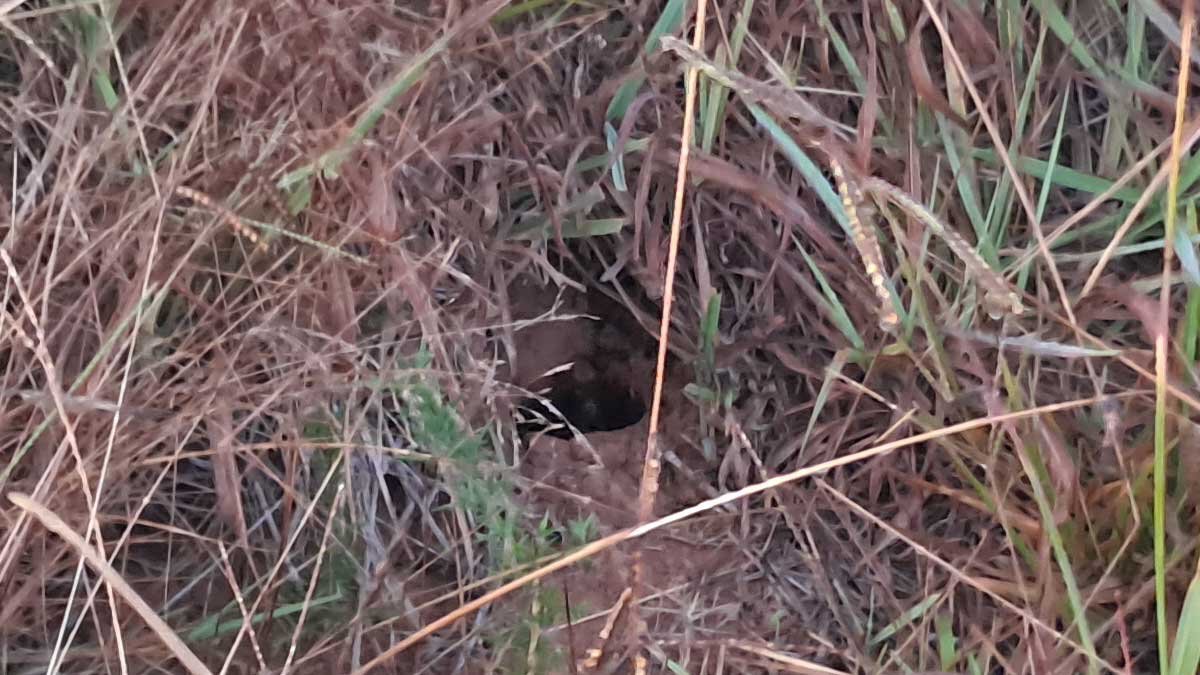For the past 5 summers, our major pest on the farm has been Polistes paper wasps. But this year has been different.
Maybe it was the heat-wave followed by a cold snap in December. Perhaps there’s a food source doing really well, or the (lack of) rainfall this year has been ideal. It could be something else entirely.
I don’t know, but this year I’ve noted significantly more Vespula wasp activity than we’ve experienced in previous years.
No matter where I went on the farm, they seemed to be there. Hovering over paddocks, buzzing in the bush, zooming over the race. It’s been problematic.
Identifying the problem
On a late-February evening, I was standing on my deck and watching the cows kick and dance around a paddock. I thought to myself “it kind of looks like they’re being attacked by wasps“. But cows can be silly buggers around sunset, and they calmed down soon enough.
Then a couple of days later, I was out spraying gorse in that paddock. In the same area I’d seen the cows kicking about, I noticed a cloud of wasps in the air. I stayed alert and worked around them. But as I was reaching the end of my spray tank, I saw it.
I didn’t see it for long because I turned around and skedaddled quick-smart, but the image seared itself into my brain. A dark black hole about 7cm across, built into a bank with a constant stream of wasps launching out into the air.
I dubbed it ‘The Hellmouth’.

Once I got home, I sat and thought about it. I connected the events and realised those wasps were a legitimate animal health hazard for us. Not to mention, we live very far away from emergency medical assistance. With so many wasps around, the human, bovine, and canine risk of tripping over a nest was too high to ignore.
Vespula wasps are recognised as pests in New Zealand, with significant economic and ecological impacts. A poison called Vespex has been developed that allows nests to be eradicated at scale, even if you don’t know where they are.
So by the end of that day, I had studied for and passed the online test to become a Vespex Approved User. By the end of the week I was registered, and waiting for my supplies to turn up.
What is Vespex?
There are two families of stinging social wasp in New Zealand: Polistes (paper wasp) and Vespula wasps. You can go back to my post on paper wasps for a refresher on the difference.

Paper wasps in New Zealand
Polistes paper wasps are introduced pests in New Zealand gardens. Or are they?
Both species need to collect protein to feed their larvae. However while Polistes wasps are out stealing your monarch butterfly caterpillars because they insist on a live-diet, Vespula wasps aren’t as picky. They’ll happily forage for dead protein, which is the behaviour Vespex relies on.
Vespex is a poisoned protein bait. When the wasps are actively foraging for protein in late summer and early autumn, you set your bait stations.
Wasps retrieve and take the poisoned bait back to their nests, and it wipes out the lot of them.
In theory, I figured it would allow me to completely eradicate the problem in a little over a week. It’s much easier and safer than hunting down all the nests (which may not always be accessible), and poisoning them individually.
To use Vespex, I first had to pass an online test and become an Approved User. There’s a fee for registering, and that’s why I hadn’t done it years ago—Vespula wasps have only actively been a problem this season, so there hadn’t been a real reason to make the investment.
But once approved and registered, I was able to order the poisons, bait stations, and other equipment. When all was said and done, it cost about $300 to get approved, buy the initial supplies, and have them delivered.
Plan of attack
It took about 3 days to get through the registration process, and another week before my supplies were dispatched. So I had time to make a plan.
Vespex needs to be laid out in a grid. The distance between bait stations is dependent on how much land you’re treating. Our stations are laid at approximately 100m x 50m apart. This year, I’m just focussing on the three paddocks we actively graze.

I chose places where I knew I’d have somewhere to attach it using existing fence posts and trees, and where I could keep it away from the dogs, waterways, and the cattle. It’s a requirement that Vespex be kept at least 2m from any water courses, and at least 70cm (and preferably 1.5m) above the ground.
Then it was just a matter of waiting for everything to turn up, and an 8-day a sunny period (because wasps don’t forage in the rain).
I temporarily fenced off The Hellmouth to prevent the cows disturbing it again in the meantime.
Wasp activity testing
Before I could set up my ‘sting’, I had to test to see whether the wasps were foraging for protein in a high enough concentration. This ensures they will actually take the poisoned bait during the 8-day treatment period.
I needed to find at least 10 wasps foraging off 20 lures.
An easy job, except for the 2 dogs who follow me everywhere and would probably make laying little plates of raw meat quite difficult!
Activity testing needs to be done on a sunny day, around midday. So I turned on the air-con and locked the dogs inside. Then I went out for a walk with 20 jam lids and a can of tuna in springwater.

I laid a path of lures every 5 meters in the paddock containing The Hellmouth. Then I went home to wait an hour before doing the count.
But what I found when I went back out was mostly ants and flies. I counted 6 wasps. Not enough. I was disappointed, but at least the dogs enjoyed cleaning up the 20 little plates of tuna I came home with.
Still, when I went to check the weather there was a rainy day in the near future. And the gloves I needed were being delivered separately, and yet to arrive. So I decided to try again in a few days.
In the meantime, my father had mentioned he’d seen a number of wasps feasting on a possum carcass while out hunting. So I sent Richard and Roxy out one night to get a few possums.
On my second attempt at the activity testing, I used random hunks of possum as a lure. That was significantly more effective.

The second activity test landed me 11 wasps over 20 plates. We were good to go.
Setting Vespex bait stations
Once my gloves had shown up, and the next 8 days looked clear of rain, I was ready to set the bait stations.
I did this in the morning, aiming to have all 12 of them out before midday. I’d de-frosted the Vespex and charged up the battery for my drill the day before. I loaded up my bucket with the poison, bait stations, an electric drill, gloves, and screws.


I began by setting up our warning sign at the gate. These need to be displayed at entrances to a private property.
Then I trotted around the spots on my map with the dogs, and set up each of my bait stations.

Note that this tree grows on a steep bank and the trap is 1.6m above the ground level on that side of the trunk. Roxy is on the high side of the bank.
Be warned, the bait really stinks. As soon as I broke the seal on the plastic encasing the container I could smell it. For some reason this surprised me, even though it makes sense when you’re trying to attract wasps. Either way, I was glad to have my gloves.
Once the stations were set up, it was time to wait. In 8 days I’d need to pull it all down again, but for now I just needed to let time pass.
Still, I couldn’t help but check the bait station closest to the cabin. I was amazed to see half the bait gone after a couple of days.

Just after setting the trap.

Half-way through the operation.
Three or four days in, it began to feel like there were just fewer wasps around. When I’d done the activity test, they were everywhere. But soon enough they had just… disappeared.
The place felt really quiet. As if a background noise had been suddenly switched off. The constant buzz-hum the wasps had provided was gone.
Collecting and disposing of bait stations
In the early evening of the eighth day, the dogs and I re-traced our steps and took the bait out of each of the stations, disposing of it in a thick plastic bag.
I took down the stations as I went. They all still contained some bait. It had dried out and shrunk. I think by the end of 8 days it’s much less attractive to wasps anyway.
It took a full month between making the decision to do this, and completing the operation. Because Vespex is seasonal, it’s probably getting a bit late for a new user to get started in 2025. Next time it will be faster because I’ll have the majority of what I need, but the first time takes time for all the pieces to line up.
As I walked around, I kept my eyes and ears open. There are still a few wasps about, but there’s been an incredible decline.
Finally, I took down the sign at the front gate, and packed everything away safe for the next operation. If the weather plays ball, my neighbours would like their place done too.
The bag of leftover baits were sealed, labelled, and disposed of in our household trash. They’ll be dumped at the transfer station when we go next week.
Re-visiting The Hellmouth
At sunrise yesterday, I crept out to take another look at The Hellmouth. Its location means I can’t just let it be, it’s too dangerous and absolutely has to go.
I knew the nest was still alive and operating, though hopefully weakened as a result of the Vespex. So I took a can of wasp spray with me.
If I could kill the queen, the colony will collapse.
Wasp sprays contain an ingredient that paralyses the wasps on contact, and they can also propel the spray a longer distance, so I didn’t have to get too close. Regular fly sprays do not contain this ingredient, or spray as far, making this job more dangerous. It’s a braver person than I who chooses fly spray over wasp spray in this situation.
Doing this at first light was the safest time. The wasps aren’t yet warm enough to be very active, but there’s enough light to see. I’m wary that a bright light like a torch just gives the little beasties a target.
My biggest worry was finding it again, and that did take a few minutes, but my abandoned spraying left me a couple of clues, and I managed to locate it without stepping on it. Things were quiet so I took a couple of photos first, then let rip with most of the can of wasp spray.
Then I skedaddled again.

Time will tell if I got the queen. I’ll have to keep an eye on it over the next week or so, and I’ll keep it fenced off from the cattle for now.
Final thoughts
It’s not quite the result I was hoping for when I began this exercise, but I do think it’s been valuable. While there are still some wasps around, I’d say they’re significantly reduced. The background buzz isn’t as persistent.
Next year, I think I’ll set up a protein-based wasp trap in early January and keep an eye on what it catches. I regret not setting one up before I started to have a better measure of actual impact.
I’ve made a note in my diary to make a Vespex order before Christmas, and I plan to grab some more bait stations to do an even larger area next season.
It’s clear that on a “good year”, wasps are a significant hazard here. I suspect the best way to prevent that is to stay on top of them even on the more middling years. If I’d taken it more seriously in the past, it would be less of an issue now.
Unfortunately, Vespex isn’t a magic wand. It’s one tool in the toolbox. If you have a specific nest causing you trouble, it’s probably more effective to poison it directly. But Vespex does appear to reduce the overall numbers to more tolerable levels when used as directed.
Some notes and useful things
Please be aware this entire piece is specific to Aotearoa New Zealand where Vespula wasps are an introduced pest species with significant environmental and economic impacts. I would not recommend this approach in countries Vespula wasps are endemic.
To become a Vespex Approved User you need to study for, and pass an online test. This is not particularly difficult, but is the first step to gaining access. The test and study materials are free, but there is a fee to register. You can get started on the Merchento website.
The only place to buy Vespex is the Merchento website. You must be an Approved User to purchase the active product, but anyone can buy the accessories such as bait stations, gloves, and signs.
An entirely different bait and poisoning system is available in Australia, which is very confusingly also called Vespex. This blog is about the New Zealand Vespex, and is not applicable to the Australian product.



Thanks Kat, for sharing how this all works. I’ve seen the bait stations on walks in conservation areas and wondered how the system worked. We have had a heap of introduced wasps this year in urban north Canterbury this year. I am sure we have a nest near. I also have seen paper wasps in the act of stealing my monarch caterpillars which solved the mystery as why they kept disappearing.
Setting bait stations is probable not viable in a backyard garden but it is good to know about the wasp spray if we find a nest.
Suburbia is a bit more complicated, but if you can get a few neighbours with adjoining sections together, it could be possible. Or if you have a local Predator Free group, you could see if something could be co-ordinated via their networks. Paper wasp nests are easier and safer to kill. They’re barely pests in comparison to Vespula, which are angrier and more persistent!!
I was first introduced to wasps when living on our lifestyle block and happen to be mowing on the tractor doing a 3 monthly grass mow and just happen to look behind me going down a slight hill and I mow inches away from a hole in the bank with wasps coming and going. Out of there fast. So late in the evening in the dark, with a torch and 1 litre of petrol and oil in a bottle, approaching the hole in the bank which I guessed was the nest entrance to the nest, turned off the torch, and quickly emptied the contents of the petrol and oil and stuff the entrance / exit hole with a large wad of old rags, and ran.
I had to repeat the same exercise for our neighbour as they had a wasp nest on the side of their drive. Everyday the lady would shuffle down the long drive to their letter box, walking past and not noticing the heavy wasp activity coming and going into their nest. Thankfully she was never sting and I managed to knock that nest out also.
The above will work for the small nests but an established nest that has a few seasons to build up might just be that much harder to knock.
As with most things it always pays to get on top of the pests on the lifestyle block. Be it rabbits, possums, rats, mice and heaven forbid peacocks .
Haha, thankfully no peacocks (or, for that matter, turkeys) here. I struggle with the petrol solution because peak wasp season is also peak fire season, and we’re surrounded by bush. Even though a spark is unlikely, I don’t really feel comfortable adding the fuel. I reckon a few seasons with Vespex and they’ll be manageable, but it’ll take some experimentation to get the right number of stations, in the right places, at the right time. I’m happy with how this went for a first attempt.
I went out to check a pear that had dropped off my neighbors tree. It was dinner for a swarm of wasps. Don’t know which type but a good spraying and at lest 10 wasps have gone to wasp heaven.
What do these swaps you are killing look like.
There’s photos and comparisons on the Paper Wasps post – this one was too long to repeat all that. This is about German and Common wasps (Vespula spp.) It’s very likely they were the ones this post refers to, I’ve seen a few people say they can’t get to their pears because of the Vespula wasps!